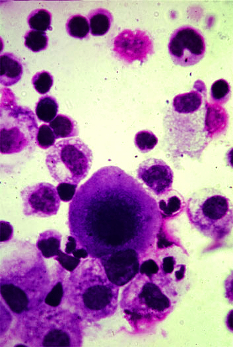New cancer tools tested
 Australian researchers are working on a new arsenal to target leukaemia and other cancers.
Australian researchers are working on a new arsenal to target leukaemia and other cancers.
A discovery by a QIMR Berghofer-led team of international scientists has potentially unlocked an entirely new approach to targeting the blood cancer, acute myeloid leukaemia, bringing hope to patients who are no longer responding to existing treatments.
The findings, published in the journal Nature Cancer, are highly significant not only for advancing the treatment of blood cancers but potentially other types of cancer too.
The researchers made their unexpected discovery while investigating why a new class of drug, imetelstat, was effective at killing leukaemia cancer cells in the laboratory.
They found the drug induces a type of cell death that has only recently been discovered, known as ferroptosis. The scientists also showed for the first time the detailed biological process that triggers this cell death in leukaemia samples treated with the drug.
The findings have led to a world-first phase II clinical trial of the drug in patients with myelodysplasia and acute myeloid leukaemia which is underway at the Royal Brisbane and Women’s Hospital and Royal Adelaide Hospital in Australia, and sites in Germany and France.
“This is very exciting because it essentially means we potentially have a new weapon to kill blood cancer cells and an instruction manual that explains how the weapon works,” says QIMR Berghofer’s Professor Steven Lane
Blood cancers are often diagnosed when they have spread through the body so treatments like surgery and radiation are far less effective.
Traditional chemotherapies sometimes stop working and there are some patients who do not respond at all.
Novel treatments that target the blood cancer throughout the body are urgently needed.
“Having this extra weapon in our arsenal would create so much opportunity particularly in combining this drug, and others like it, with existing treatments like chemotherapy and other novel cancer therapies,” Professor Lane said.
“This could transform the way we think about treating patients with blood cancers, especially those who have run out of options.”
Lead author Dr Claudia Bruedigam says the project was a huge effort over many years, requiring “many late nights and weekends”.
“We were interested in the drug, imetelstat, because it targets the telomeres which are DNA sequences at the end of chromosomes.
“We used cutting-edge functional genetics experiments to basically knock out every single gene of the human genome in the patient samples to try to understand why it was effective against leukaemia.
“It really was a ‘eureka moment’ when we found there was this other separate process taking place as well, the cell death pathway ferroptosis. That was incredibly exciting,” she said.
Scientists globally have only just begun to explore the potential of ferroptosis, which was discovered only a decade ago.
It is distinctly different to other types of cell death such as apoptosis, so could provide untapped methods of targeting cancers.
This research increases understanding of this new cell death pathway which could be significant not only for new treatments for blood cancers, but other cancers as well.
The scientists found the drug, imetelstat, enters the leukaemia cancer cell and interacts with two important enzymes that regulate fatty acid metabolism.
This causes changes that lead the cell membrane to rupture which eventually results in leukaemia cell death.
The international phase II clinical trial of the drug in acute myeloid leukaemia patients is at the halfway mark, with the team looking to recruit another 25 patients.








 Print
Print